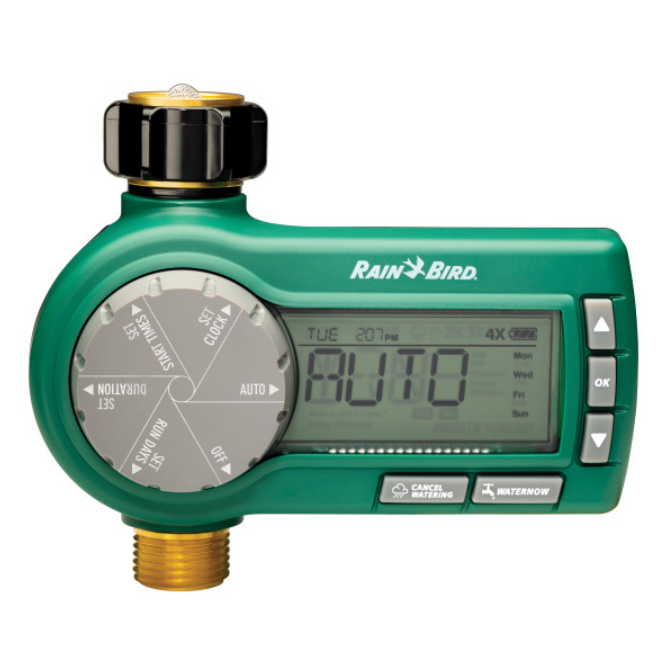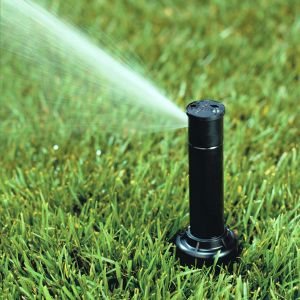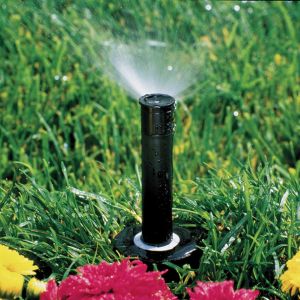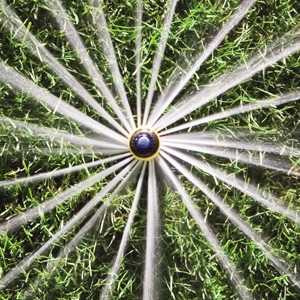HOW TO PROPERLY WATER A LAWN
Learn the 1-2-3-2-1 Lawn Watering Technique
A Lawn Watering Technique Based on Science
Benefits of Proper Lawn Watering
- Promotes Deep Digging Grass Roots
- Stimulates Beneficial Microbial Activity in the Soil!
- Prevents Lawn Diseases like Necrotic Ring Spot and Ascochyta Leaf Blight
- Saves Water
- Prevents Grub Infestations
- Designed for Both Lawn Health and Tree Health
- A Watering Technique Based on Logic
The 1-2-3-2-1 Technique
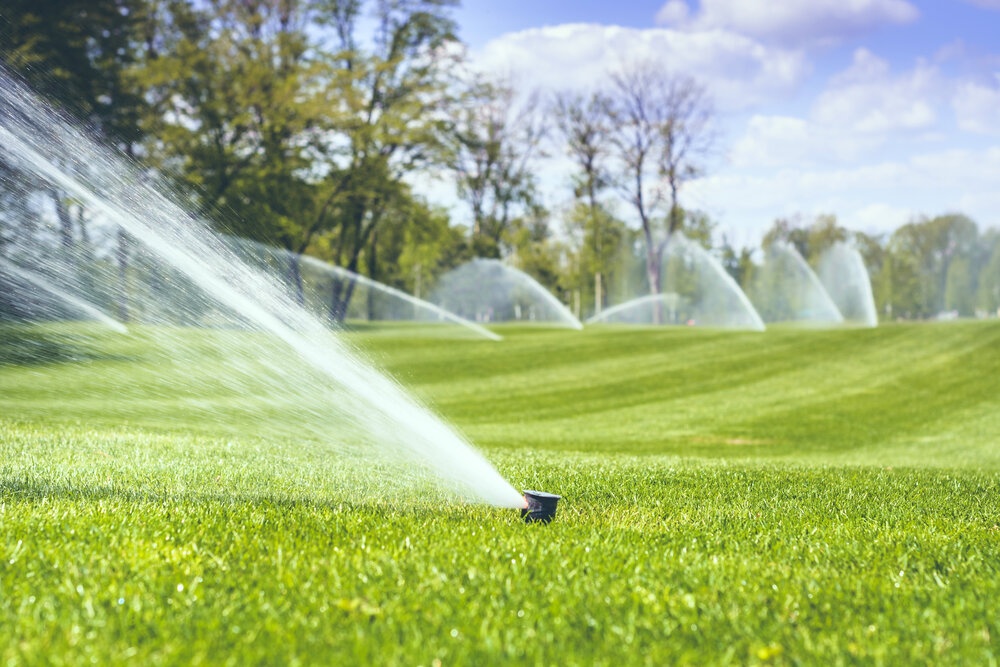
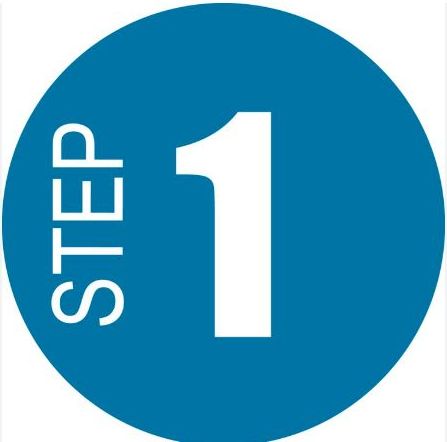
What Time of Day is Best for Lawn Watering?
The Final Zone Should Finish as Close to 6:00 AM as Possible.
If this isn’t feasible, the next best option is to water the lawn in the late evening. When watering deeply and infrequently, evening watering should not lead to lawn fungus problems in Colorado’s dry climate.
Programming the clock to end around 6:00 AM can be a bit challenging. First, you need to add up the total run time for all the zones. Then, subtract that total time from 6:00 AM. While this may sound straightforward, calculating time can be more complex than it seems.
Why is Early Morning the Best Time of Day to Water a Lawn?
Cooler Temperatures: During these hours, temperatures are cooler, and there is less evaporation, so more water is absorbed by the soil and roots.
Calmer Winds: Mornings often have less wind, reducing water loss due to wind drift.
Healthier Grass: Watering early allows the grass blades to dry shortly after the sun rises, reducing the risk of diseases like fungus that thrive in wet conditions.
Last Zone Finishes by 6:00 AM – Final zone watering should be completed by 6:00 AM. Larger lawns may take longer to finish depending on their watering needs.
Early Morning
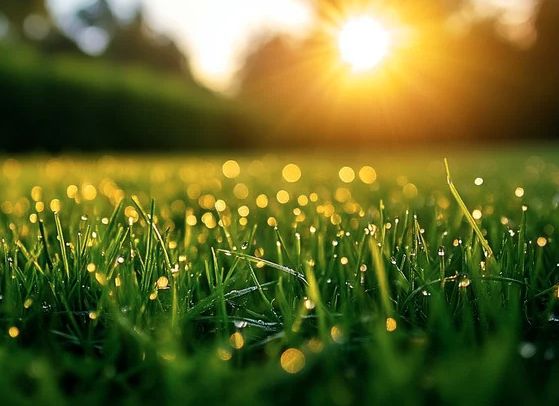
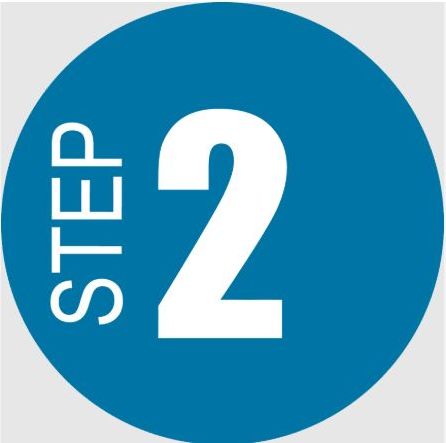
Each Individual Zone's Programming Time is Based on 2 Main Factors
#1 -Sun Exposure
and
#2 Style of Sprinkler Head
Sun Exposure – North, South, or East/West Facing Exposure
Style of Sprinkler Heads Used in Each Zone – Rotary, MP Rotator, Impact or Popup Style Heads
Each Zone Will Most Likely Be Programmed with a Vastly Different Time
Example
Zone 1: North-facing pop-up zone might be programmed for 6 minutes of watering.
Zone 2: South-facing rotary zone could be programmed for 55 minutes.
Zone 3: East-facing rotary zone could be programmed for 40 minutes.
Note: Adjustments to sprinkler run times might be necessary based on overlap and nozzle outpu
Programming Individual Zone Times
Every sprinkler system is unique and depends greatly on its design and installation quality. The sprinkler zone time chart below can provide a useful starting point for programming your sprinkler clock. To achieve optimal accuracy, it is best to measure the output of the sprinkler system using rain gauges or have Organo-Lawn perform a sprinkler audit for your system.
Note: Organo-Lawn’s sprinkler technicians do not measure your sprinkler system’s output, but our technicians have a lot of experience with programming clocks correctly.
Rotary Style
Sprinkler Heads
Rotary-style heads are designed to water large areas of grass efficiently. They move back and forth slowly, which requires longer watering times to achieve the same output as other sprinkler head styles.
Sun Exposure:
Full Sun or South Facing Aspects:
50-60 minutes total run time
~ 3/4 inch of water
Partial Sun or East / West Aspects:
40-50 minutes total run time
~ 1/2 inch of water
Full Shade or North Facing Aspects:
30-40 minutes total run time
~ 1/3 inch of water
Pop-Up Style
Sprinkler Heads
Popup-style heads are designed to irrigate smaller areas of grass. They are stationary and deliver a large amount of water in a short period of time. This design requires shorter watering durations.
Sun Exposure:
Full Sun or South Facing Aspects:
18-20 minutes total run time
~ 3/4 inch of water
Partial Sun or East / West Aspects:
12-15 minutes total run time
~1/2 inch of water
Full Shade or North Facing Aspects:
6-10 minutes total run time
~ 1/3 inch of water
MP Rotator Style
Sprinkler Heads
MP Rotator-style heads are designed to water grass gradually. They feature a pinwheel action that allows water to soak deeply into the soil. For proper lawn hydration, they require longer run times.
Sun Exposure:
Full Sun or South Facing Aspects:
45-55 minutes total run time
~3/4 inch of water
Partial Sun or East / West Aspects:
35-45 minutes total run time
~ 1/2 inch of water
Full Shade or North Facing Aspects:
25-35 minutes total run time
~ 1/3 inch of water
Impact Style
Sprinkler Heads
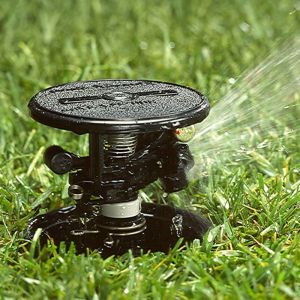
Impact-style sprinkler heads are designed to irrigate large areas of grass. They move back and forth slowly and require longer watering times to ensure the lawn is watered deeply.
Sun Exposure:
Full Sun or South Facing Aspects:
45-60 minutes total run time
~ 3/4 inch of water
Partial Sun or East / West Aspects:
35-50 minutes total run time
~ 1/2 inch of water
Full Shade or North Facing Aspects:
20-35 minutes total run time
~ 1/3 inch of water
Micromist Style
Sprinkler Heads
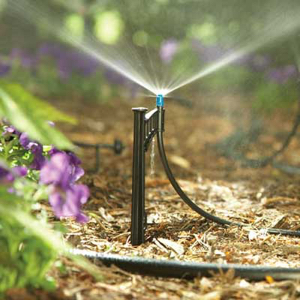
Micromist-style heads are designed to water plants in rock and mulch bed areas. They spray a mist over plants and require medium run times to water deeply.
Sun Exposure:
Full Sun or South Facing Aspects:
35-45 minutes total run time
Partial Sun or East / West Aspects:
25-35 minutes total run time
Full Shade or North Facing Aspects:
15-25 minutes total run time
Drip
Irrigation
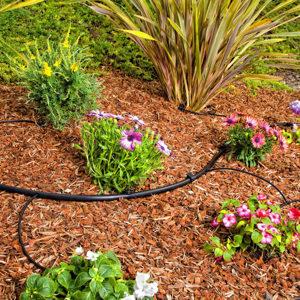
Drip systems are intended to operate for one hour. The water flow from the drip lines is not controlled by a timer but should be regulated through the emitters.
Each Drip Emitter is Rated by Gallons per Hour (GPH)
- Small plants require a 1/4 to 1/2 GPH emitter
- Shrubs require a 1 to 7 GPH emitter
- Trees require a 10 to 35 GPH emitter installed.
Therefore, the gallons per hour should not be controlled via the clock but via the emitters and the GPH rating.
*However, many sprinkler installers do not fully grasp this concept. If you find a better time based on the emitters installed at your property, we recommend that you use that time instead.*
Full Sun or South Facing Aspects:
60 minutes total run time
Partial Sun or East / West Aspects:
60 minutes total run time
Full Shade or North Facing Aspects:
60 minutes total run time
Soak and Cycle Programming
An Optional Multi-Start Watering Technique
How to Calculate for Soak and Cycle Times
Many sprinkler systems are designed to water for shorter durations but activate multiple times throughout the evening. This method, known as deep soaking with multiple cycles, is excellent for allowing water to penetrate the soil more deeply. If your sprinkler system is set up for short bursts through multiple start times, you can calculate the total watering time for each cycle.
South Facing Rotary Heads with 3x Soak Cycles Example:
Soak #1 – 1:00 AM Start Time – 18 minutes run time
Soak #2 – 2:00 AM Start Time – 18 minutes run time
Soak #3 – 3:00 AM Start time – 18 minutes run time
Total Watering Time = 54 Minutes
Divide 55 minutes/ 3 times per night
55 / 3 = 18.3333 minutes per soak cycle (Round down to 18 minutes)
Total watering time for a south facing rotary zone is typically around 55 minutes.
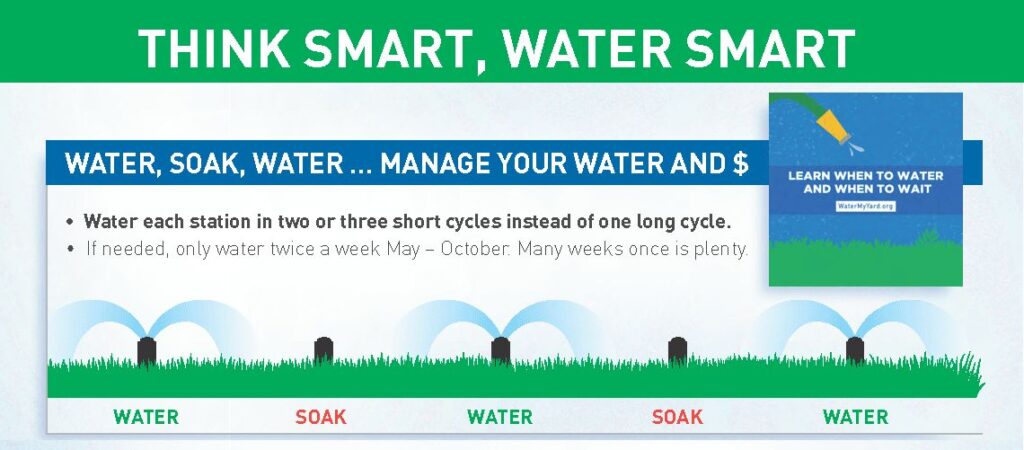

HOW MANY WATERING DAYS PER WEEK?
Based on the Seasonal Temperatures
Spring: 1 day per week watering
Early Summer: 2 days per week watering
Summer: 3 days per week watering
Late Summer: 2 days per week watering
Fall: 1 day per week watering
Note: This is how we got the name (The 1-2-3-2-1 Technique)
Start in Early Spring with 1 Day Per Week Watering
Add Watering Days as the Seasons Get Warmer
Periodically Add One Watering Day per Week as the Average Outside Temperatures Gradually Increase – (Max of 3-Day Per Week Watering)
Subtract Watering Days as the Seasons Get Cooler
Then Periodically Subtract One Watering Day per Week as the Average Outside Temperatures Decrease – (End the Year with 1-Day per Week Watering)
Spring Watering
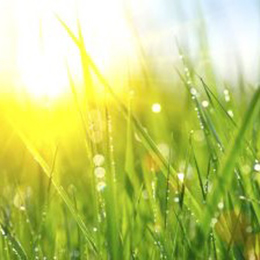
1 Day per Week Watering
Cool and Often Rainy!
(Sprinkler Startup through the End of May)
This is an important time for proper lawn watering, as we want to promote deep root growth. If a lawn is overwatered during this period, the roots will remain shallow, which will become a problem when the summer heat arrives.
Water no more than one day per week, when daytime high temperatures average below 70°F. This is generally sufficient from April through the end of May, although this may vary from year to year.
2 Day per Week Watering
Warm but not Quite Hot Yet!
(Late May – Middle June)
This time of year might be difficult on lawns. The tendency is to water more because the lawn is turning a little brown. Stay patient with 2 day per week watering and the lawn will quickly adjust to the heat.
Water the lawn no more than twice a week, when daytime temperatures tend to be between 70°F and 85°F. This typically occurs from late-May to early or the middle of June.
Watering Schedule: Mondays/Fridays, or Tuesday/Saturday.
Late Spring /
Early Summer
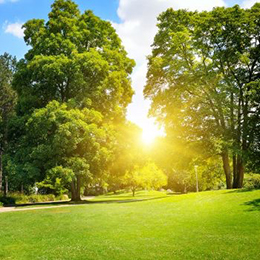
Summer (Hot)
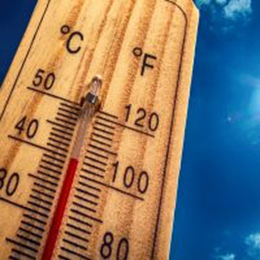
3 Day per Week Watering
Hot and Dry!
(Middle of June – Middle of August)
This time of year, your lawn may start to develop some brown patches. These areas often indicate poor sprinkler coverage, so you may need to adjust the sprinklers to eliminate these spots. It’s crucial to allow the lawn to go without water for two consecutive days. This will help kill Japanese beetle eggs and prevent damage from grubs later in September.
Water no more than 3 days per week when Colorado’s daytime high temperatures average high temperatures is above 85°F: This is typically is between mid or late June through mid or late August.
Watering Schedule: Monday/Wednesday/Friday or Tuesday/Thursday/Saturday
2 Day per Week Watering
Cooling Down
(Middle or Late August – Late September)
Reducing water usage is very important this time of year. It starts the process of preparing for winter and it prevents overwatering of the lawn. This is the time of year where overwatering will cause diseases like Necrotic Ring Spot and soil compaction.
Water no more than 2 days per week when daytime high temperatures average between 70°F and 85°F. This is typically between the middle or late August through the middle or late September.
Watering Schedule: Monday/Fridays or Tuesday/Thursday
Late Summer /
Early Fall
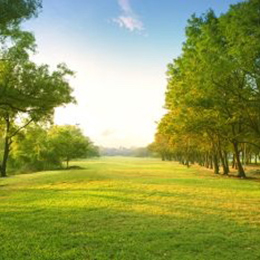
Autumn / Fall
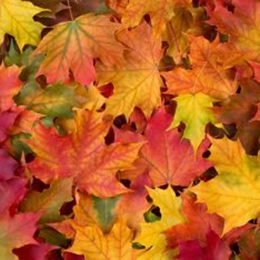
1 Day per Week Watering
Cold Nights & Warm Days
(Late September – Sprinkler Blowout)
To prepare your lawn for the winterization of the sprinkler system, it is important to reduce watering to no more than once a week. This decrease in watering will help prevent winter desiccation and damage from spider mites.
Water no more than 1 day per week when daytime temperatures are 70°F or below. One day per week watering is typically between the middle or late September until the system is winterized for the season.
Don't Change the Zone Watering Times!
Instead Change the Number of Watering Days per Week!
As temperatures change with the seasons, it’s advisable to adjust the number of watering days rather than extending the duration of each watering session. In the fall, as temperatures begin to cool, it is better to decrease the number of watering days instead of shortening the run time.
Don’t Add Additional Time During the Summer Months
Avoid altering the timing of your sprinkler system zones unless there is a significant change in the amount of sun exposure that a particular zone receives. It’s generally a poor practice to add more watering time during the summer months.
We Want the Lawn to Dry Out Between Waterings
We aim to water the lawn deeply and allow the soil to dry out between watering sessions. Deep and infrequent watering encourages water penetration to a depth of 10-15 inches, prompting grass roots to grow deeper as the surface soil dries out.
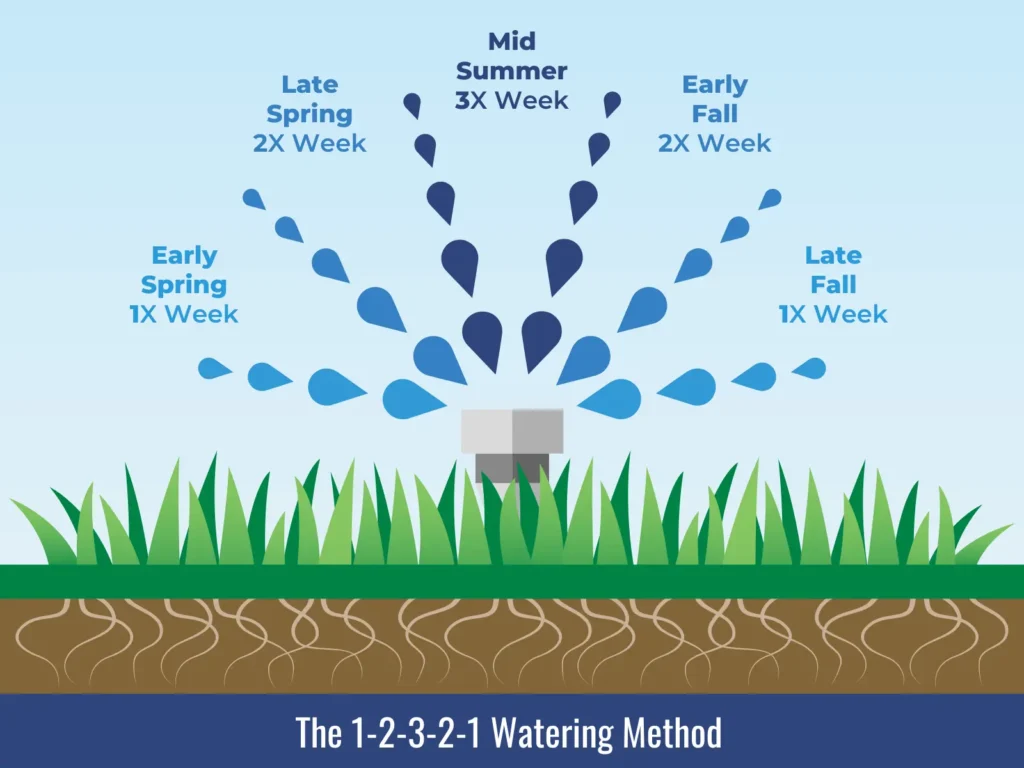
The 1-2-3-2-1 Lawn Watering Technique
Summary
Step 1 – Program the controller to water in the early morning hours.
Step 2 – Program each zone based on #1 sun exposure and #2 sprinkler head style.
South – Hot requires longer cycles
East / West – Neither hot nor full shade
North – Cool requires shorter cycles
Step 3 – How many days per week to program the controller
Spring: 1 day per week
Early Summer: 2 days per week
Summer: 3 days per week
Late Summer: 2 days per week
Fall: 1 day per week

How to Properly Water a Lawn FAQs
Is it Bad for the Lawn to Water a in the Evening?
Watering a lawn at night is generally not recommended because it can lead to potential problems for the grass and soil. However, in Colorado our humidity levels are so low that night watering is generally not a major problem. Here are the key reasons why early morning watering is slightly a better option.
Promotes Fungal Growth
Grass blades remain wet for an extended period since there is no sunlight and reduced wind to help dry the water. This prolonged moisture creates a favorable environment for fungal diseases like brown patch or necrotic ring spot to thrive. However, in Colorado our dry climate makes it less likely that evening watering will cause fungal issues in a lawn.
Night Watering
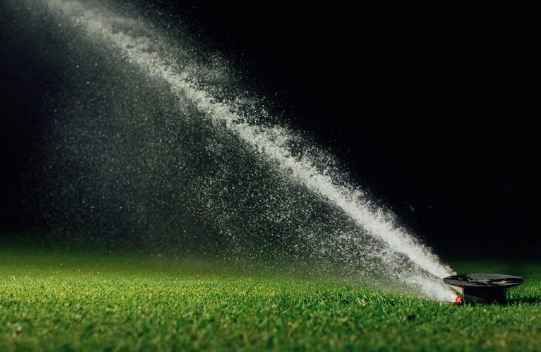
Encourages Pests
Wet conditions can attract pests such as slugs and other insects, which can damage the lawn.
Accidental Overwatering
While the soil may absorb water more slowly during cooler nighttime temperatures, excess water can lead to oversaturation or pooling, suffocating the grass roots.
Better Alternatives:
The best time to water your lawn is in the early morning (2 AM to 8 AM). This allows ample time for grass blades to dry and gives the soil optimal water absorption as temperatures are cool, and winds are usually minimal.
If Night Watering is the Only Option
If watering at night is unavoidable due to water restrictions or other reasons, try to water as early in the evening as possible, so the grass has time to dry before nightfall.
Prevent Overwatering
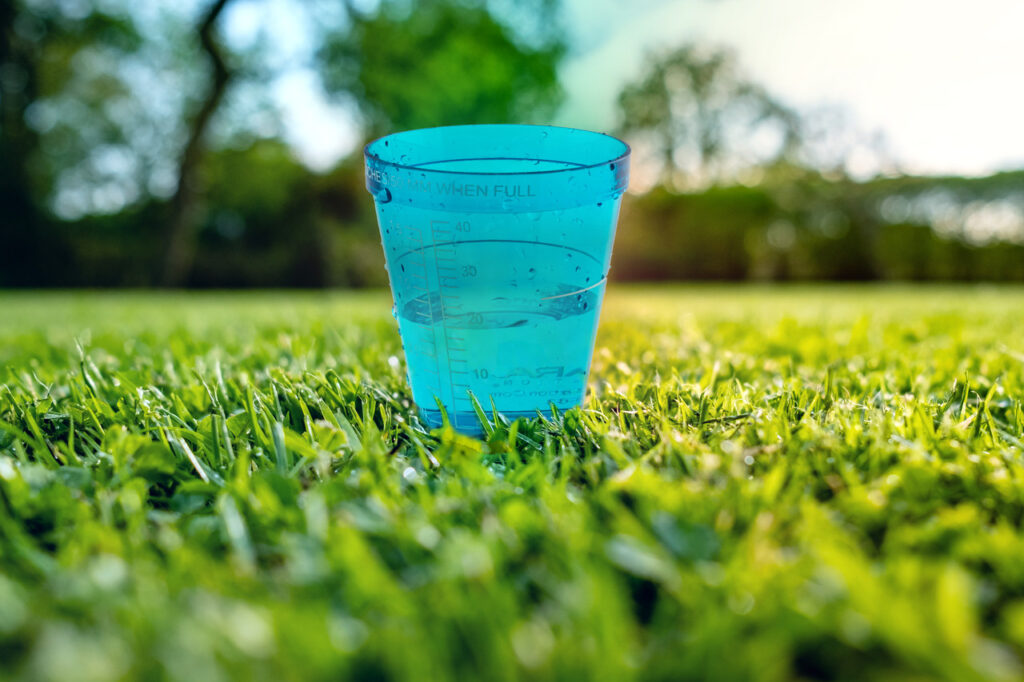
How to Water a Lawn with a Hose and Sprinkler Head?
Watering a lawn with a hose and sprinkler can be highly effective if done correctly. Here are the steps and techniques to ensure your lawn receives adequate water while minimizing waste and promoting healthy grass growth:
Choose the Right Sprinkler
-Oscillating Sprinklers: Best for rectangular or square lawns.
-Rotary Sprinklers: Ideal for circular or irregularly shaped areas.
-Impact Sprinklers: Great for large lawns with high water pressure.
Determine Watering Needs
Use a rain gauge or a shallow container (e.g., a tuna can) to measure the water applied.
Position the Sprinkler Strategically
Place the sprinkler so that it covers the lawn evenly. Overlap sprinkler patterns slightly to avoid dry patches. Adjust the sprinkler’s spray to avoid watering sidewalks, driveways, or roads.
Watering By With a Hose
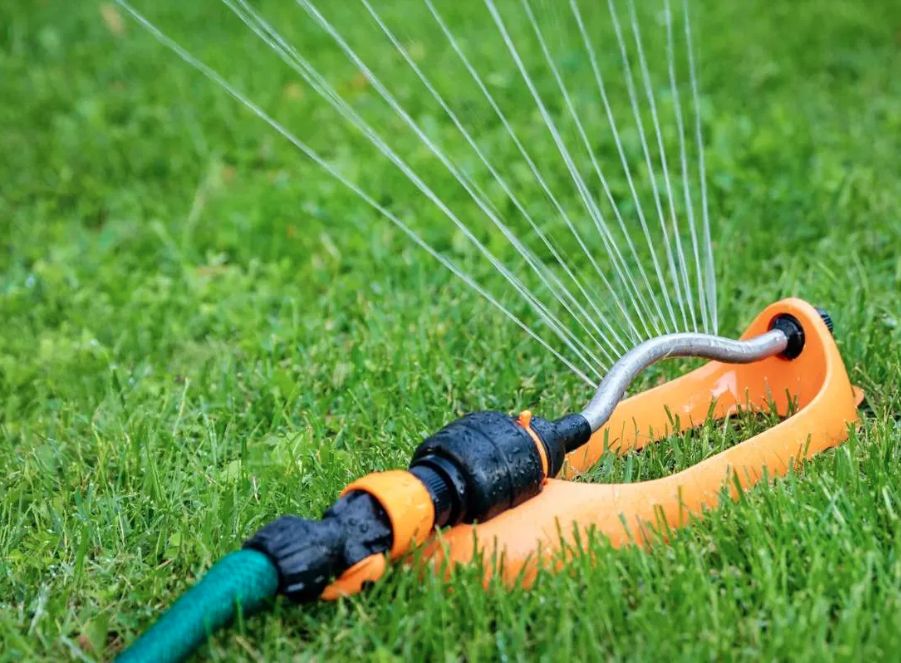
Water Deeply and Infrequently
Follow the same principles of the 1-2-3-2-1 lawn watering technique.
Pro Tip: Use a Timer
Attach a timer to your hose to ensure consistent and efficient watering, even if you’re not available to monitor the process.
By following these techniques, you can maintain a lush, healthy lawn without an automated sprinkler system.
Automatic Timer for a Hose
